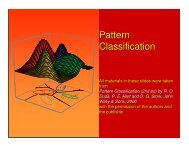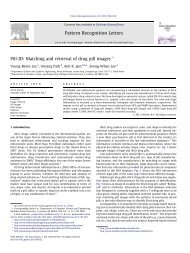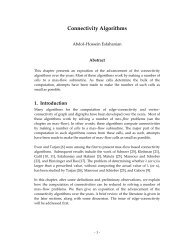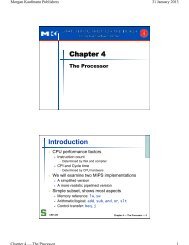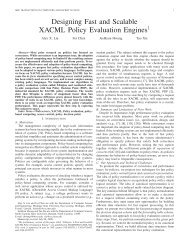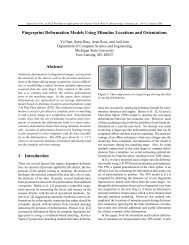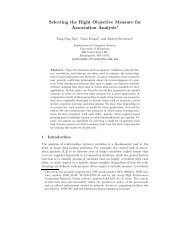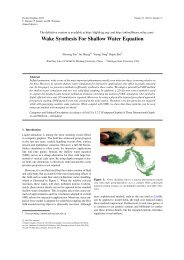Latent Fingerprint Indexing - Computer Science and Engineering
Latent Fingerprint Indexing - Computer Science and Engineering
Latent Fingerprint Indexing - Computer Science and Engineering
Create successful ePaper yourself
Turn your PDF publications into a flip-book with our unique Google optimized e-Paper software.
N is the number of minutiae, o i = {o i,1 ,o i,2 ,...,o i,n } isthe descriptor for the i th minutia <strong>and</strong> n is the total numberof sample points in the orientation descriptor [19].Given a minutia, L concentric circles are centered at theminutia with the j th circle of radius R×jL, <strong>and</strong> K j samplepoints are equally spaced on each circle starting from theprojection location of the reference minutia along its directionon the circle. In this paper, the number of circles L is4 <strong>and</strong> the numbers of sample points from the inner circle toouter circle are 10, 16, 22 <strong>and</strong> 28, respectively, <strong>and</strong> the maximumradius R for the outer most circle is 80 pixels. So,the total number of sample points for each orientation descriptoris n = ∑ Lj=1 K j =76. The feature value for eachsample point is computed as the counter-clock wise rotationangle from local orientation field at the sample point to thelocal orientation at the central minutia.In the index table generation, a set of l pairs of samplepoints {(h j ,b j )} l j=1 from the orientation descriptor is r<strong>and</strong>omlygenerated, where h j ,b j ∈{1, 2,...,n} <strong>and</strong> h j ∕=b j . Then, a bit vector r = {r 1 ,r 2 ,...,r l }, is generated as{ 1 if oi,hj >or j = i,bjj =1, 2,...,l. (3)0 otherwiseThe r<strong>and</strong>om generation of the bit vectors is repeated sothat the total number of hash functions is H O , <strong>and</strong> the numberof bits in each hash function is fixed (l). Each bit vectorcorresponds to a decimal number, which is then used as oneof the index keys. The sample points <strong>and</strong> hash functionsr<strong>and</strong>omly chosen in the index table generation step are thenused to obtain the bit vectors from the search print. Giventwo sets of orientation descriptors O 1 <strong>and</strong> O 2 , similar to theMCC index score computation, the index score for orientationdescriptor is computed as∑S O (T 1 ,T 2 ) ∼ r∈O=1(max rj ∈O 2{C F (r, r j )}) p l, (4)∣O 1 ∣×(H O ) p lwhere C F represents the number of collisions over all hashfunctions as in Equation 2.4.4. Singular PointsSingular points provide useful characterization of a fingerprint.Given a list of core points <strong>and</strong> delta points witheach singular point containing coordinates <strong>and</strong> direction information,three types of singular point pair features can beextracted [6]: 1) core pair; 2) delta pair; <strong>and</strong> 3) core-deltapair.To order the singular points in a pair of singular points,each core point pair generates two pairs with each core pointbeing ranked first once; for delta pairs, the delta points areordered based on x-coordinates; <strong>and</strong> for core-delta pairs, thecore points are ordered first. For each singular pair, threefeatures are computed: 1) the distance (d) between the singularpoints; 2) the counter-clock wise rotation angle (α)from the direction of the first singular point to the line connectingsingular points; 3) the counter-clock wise rotationangle (β) from the direction of the second singular point tothe line connecting singular points.The singular pair similarity score between latent <strong>and</strong> referenceprint isS SP = 1N∑SPN SPi=1max s i,j (5)jwhere N SP is the number of singular pairs in latent <strong>and</strong>s i,j is the similarity between the i th singular pair in latent<strong>and</strong> the j th singular pair of the same type in reference print,which can be computed ass i,j = 1 (f20,60 (Δd i,j )+f π63, π (Δα π3i,j)+f6 , π (Δβ 3 i,j) )(6)where Δd i,j is the distance difference, Δα i,j <strong>and</strong> Δβ i,j arethe angle differences between the first <strong>and</strong> second singularpoints, respectively, <strong>and</strong> f a,b (x) is a piece-wise linear function⎧⎨ 1 xb,⎩otherwise.b−xb−aIf no singular pair of the same type in the reference printcan be found, then the singular pair similarity s i is set tozero.4.5. Ridge PeriodGiven a fingerprint (either latent or reference print), theaverage ridge period is computed within a circle of radius10 blocks centered at the core point, with each block being16 × 16 pixels; only foreground blocks are used. If there isno core point in the print, the center point of the foregroundregion is used. The ridge period similarity is then computedas(S R =exp − ∣R )l − R r ∣(8)σ Rwhere R l <strong>and</strong> R r are the average ridge periods in the latent<strong>and</strong> the reference print, respectively, <strong>and</strong> σ R is a normalizationterm which is usually set to the average of ∣R l − R r ∣.In this paper, σ R is set to 2.4.6. Fusion of <strong>Indexing</strong> ScoresThe indexing scores based on different features (triplets,MCC, orientation field descriptor, singular points <strong>and</strong> ridgeperiod) take values in different ranges. Thus, normalizationof individual indexing scores is done before the fusion.Let s = {s 1 ,s 2 ,...,s N R} be the list of scores correspondingto a latent, <strong>and</strong> N R be the number of reference(7)




